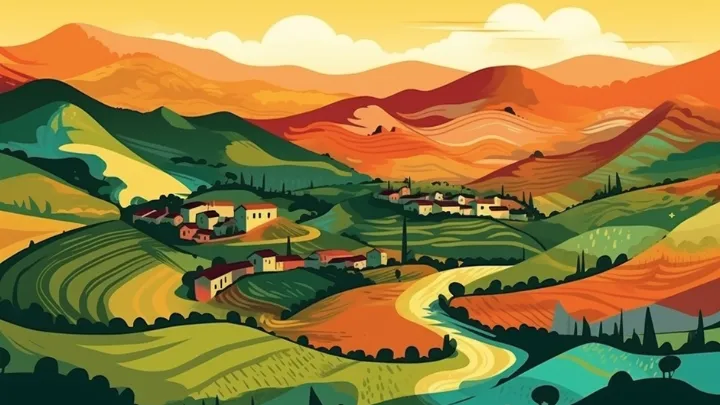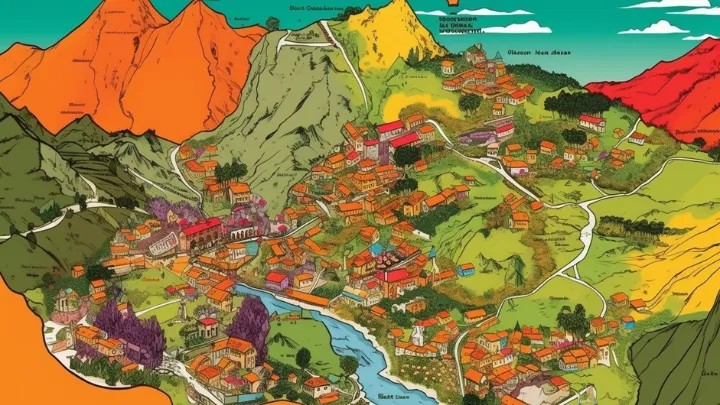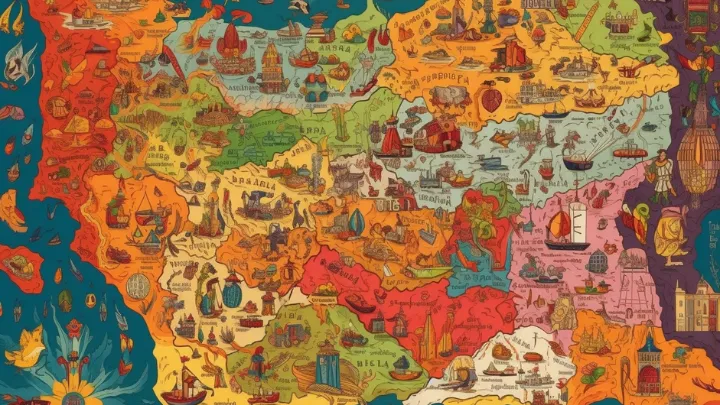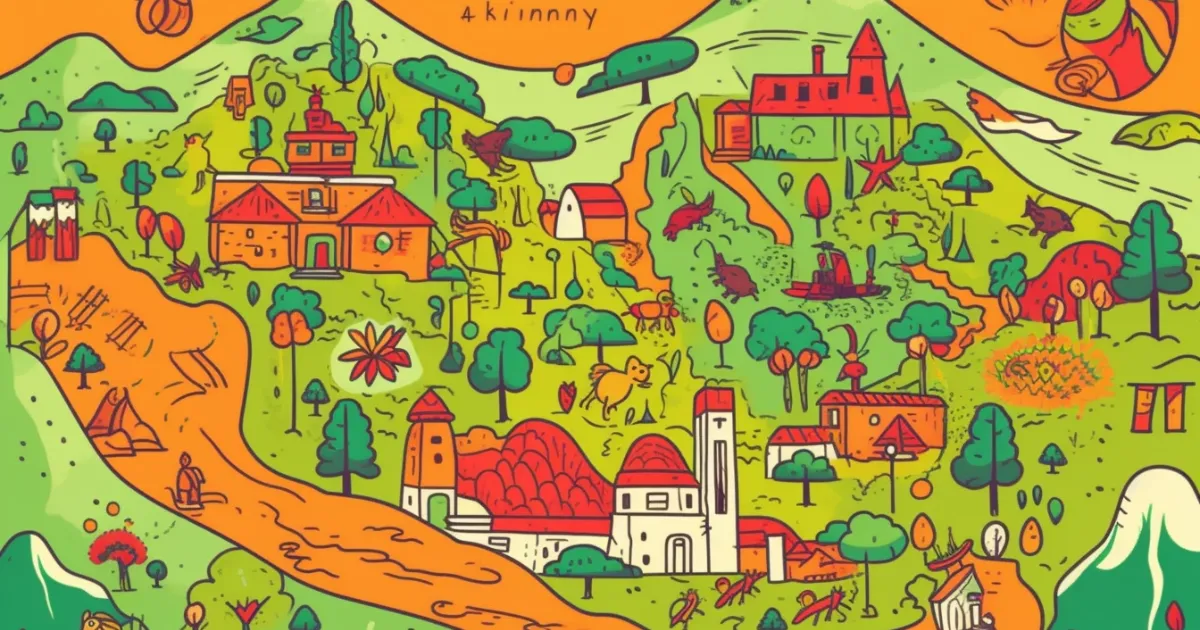This post may contain Amazon affiliate links which means, as an Amazon Associate, I may receive a small commission from purchases made through these links at no cost to you. I only recommend products I have personally used. To learn more, please see my privacy policy page.
Discover Albania’s intriguing little-known facts: its ubiquitous communist era bunkers, spooky haunted spots, and the unique Albanian language, a linguistic treasure with no close relatives.
Key Words
- Albania
- Balkans
- Bunkers
- Cold War
- Culture
- Enver Hoxha
- Isolationism
- Linguistics
Join me on this fascinating journey to discover more about Albania’s interesting characteristics. Uncover the stories behind its bunkers, the spooky spots to visit, and the marvels of its unique language. Read on…
Introduction
Situated in the heart of the Balkans, Albania is a land shrouded in mystery and rich in history. Often overlooked by the mainstream traveler, this enigmatic country offers unique experiences that defy conventional expectations. In this exploration, we explore three of Albania’s most fascinating aspects: its crazy Cold War bunkers, haunting tales that linger in its landscapes, and the unique charm of the Albanian language.
As we journey through Albania’s little known aspects, we’ll uncover the historical significance of its thousands of bunkers, remnants of a bygone era marked by isolation and fear. We’ll wander through haunted locales that tell tales of a past steeped in legend and folklore. And, in a linguistic twist, we’ll delve into the peculiarities of the Albanian language, a linguistic isolate that stands as a testament to the country’s unique cultural evolution.
Join me as we pull back the layers of Albania’s interesting history, culture, and language. Whether you’re a history buff, a language enthusiast, or simply a curious traveler, Albania’s untold stories are sure to captivate and inspire.

Albania's Bunkers - A Legacy of Isolation and Reinvention
Scattered across Albania’s landscapes are over 173,000 concrete bunkers, a peculiar yet telling legacy of its past. These structures, remnants of the communist era under dictator Enver Hoxha, were part of an extensive militarization project. From 1944 to 1985, Hoxha, driven by paranoia and a doctrine of self-reliance, initiated their construction to protect against potential invasions. This “bunkerization” transformed Albania into one of the world’s most fortified countries per square mile, symbolizing a period marked by extreme isolationism.
These small, nearly indestructible bunkers were designed as mini-fortresses, a physical manifestation of a regime rooted in fear and suspicion. Their extensive network not only drained resources but also stood as stark reminders of Albania’s detachment from the world during the Cold War.
Today, these bunkers have transcended their original purpose, integrating into the fabric of contemporary Albanian society in various creative and practical ways. They serve as a testament to the resilience and ingenuity of the Albanian people. Some of their current uses include:
Quirky Cafés and Bars: Offering a unique historical ambiance, some bunkers have been converted into popular social spots.
Artistic Canvases and Galleries: Artists utilize these structures for art installations, blending history with contemporary creativity.
Historical Museums: Several bunkers now house exhibits, particularly highlighting the communist era’s history.
Unique Accommodations: Transformed into hostels or guesthouses, these bunkers provide a distinct lodging experience.
Secure Storage Spaces: Leveraging their durability, some bunkers are used for safe and weather-resistant storage.
Tourist Landmarks: Many bunkers, preserved in their original state, have become attractions, complete with guided historical tours.
Memorabilia Sites: As military memorabilia sites, they house artifacts and recount tales from the Cold War period.
Innovative Residences: A few bunkers have been remodeled into private, albeit unconventional, homes.
Community Hubs: Serving as local meeting points or community centers, they foster communal interaction.
Music and Cultural Venues: Their unique acoustics make them suitable for musical performances and cultural events.
Agricultural Use: In rural areas, they are repurposed for farming needs, like storing feed or sheltering livestock.
Emergency Shelters: Some continue to fulfill their original role as safe havens during natural disasters.
This transformative journey of the bunkers, from symbols of isolation to multifaceted cultural assets, mirrors Albania’s own path towards integration and progress. They are not just relics of a bygone era; they are vibrant parts of Albania’s cultural landscape, representing a nation’s ability to adapt, overcome, and repurpose its history for a hopeful future.

Haunted Albania - Tales from the Shadows
Albania, a land steeped in history and folklore, harbors a mysterious side where the spectral and the unknown merge with the everyday. The country’s rich tapestry of legends and ghost stories is as captivating as its scenic landscapes. In this section, we explore some of Albania’s most haunted locations and learn a bit more about the chilling tales and ghost stories that linger in these ancient spaces.
The Sazan Island: Notorious for its abandoned military facilities and secretive past, Sazan Island is shrouded in tales of ghostly soldiers and unexplained occurrences. The island’s eerie silence is often pierced by whispers of the past, making it a haunting destination for the intrepid explorer.
Dajti Mountain: Near the capital city of Tirana, Dajti Mountain is enveloped in paranormal lore. Local stories speak of ghost sightings and otherworldly noises within its dense forests, adding a layer of mystery to its natural beauty.
The Castle of Gjirokastër: This 12th-century castle is not just a historical monument but a repository of ghostly tales. Visitors and locals alike speak of strange happenings within its ancient walls, where history seems to come alive in the most haunting ways.
Zekate House: In Gjirokastër, the well-preserved Zekate House is known for its eerie atmosphere. Legends of mysterious events and spectral figures make it a focal point for ghost hunters and history enthusiasts.
The Tunnels of Tirana: The labyrinthine tunnels beneath Albania’s capital, relics of the communist era, are said to echo with unexplained sounds and shadows, creating a spine-chilling experience for those who dare to venture below.
The Fortress of Bashtovë: Near the Shkumbin River, this ancient fortress is wrapped in ghostly legends, with tales of chilling encounters and a sense of otherworldliness that pervades its ruins.
Berat Castle: Surrounded by myths and legends, Berat Castle is a hotspot for paranormal activity. The castle’s storied past is brought to life through tales of ghostly apparitions and unexplained phenomena.
The Abandoned Soviet Submarine Base on Sazan Island: Adding to the island’s haunting allure, this abandoned base is rife with stories of spectral soldiers and eerie, unexplained sounds that resonate through its empty halls.
The Ghost Town of Qeparo: The mostly abandoned village of Qeparo, with its desolate beauty, is said to be home to spectral figures that roam its ruins, a haunting reminder of its once vibrant past.
Rodoni Castle: Built by the legendary Skanderbeg, this 15th-century castle is a treasure trove of local legends and ghost stories, its battle-scarred walls seemingly echoing tales of its tumultuous history.
Each of these locations add to the ghostly landscape of Albania. They offer a glimpse into a world where the past and the present, the real and the unreal, converge. From eerie islands to ancient castles and mysterious tunnels, haunted Albania is a realm that invites the curious to explore its shadowy corners and uncover the stories hidden within.

Shqip - The Uniqueness of the Albanian Language
In the diverse landscape of European languages, Albanian stands out as a linguistic enigma. Known as Shqip by its speakers, this language’s journey through history has left it with a character distinct from any other. As we explore the origins and features of the Albanian language, its status as a unique branch within the Indo-European family becomes evident.
Origins and Evolution: Albanian’s roots can be traced back to the Paleo-Balkanic languages, though its exact lineage remains a subject of scholarly debate. This language has evolved in relative isolation compared to its Indo-European counterparts, carving out a unique path in the linguistic landscape of Europe.
Stand-Alone Branch of Indo-European: Albanian is a unique branch of the Indo-European language family, with no close relatives. This singularity is particularly fascinating for linguists, as it stands alone unlike other language groups like Romance, Germanic, or Slavic.
Complex Morphology: The language is marked by a rich morphological structure. It has a detailed system of noun cases and verb conjugations, lending it a complexity that is less prevalent in many other Indo-European languages.
Lexical Borrowings: Reflecting the country’s diverse historical influences, Albanian has incorporated words from Latin, Greek, Turkish, Slavic languages, and Italian. This lexical borrowing has given the language a rich and varied vocabulary.
Two Primary Dialects: Albanian is divided into two main dialects: Gheg in the north and Tosk in the south. These dialects exhibit significant differences in pronunciation, vocabulary, and syntax, highlighting the language’s internal diversity.
Ancient and Modern Features: The language retains certain ancient Indo-European traits that have disappeared in other languages of the family. At the same time, it has developed modern features, showcasing a blend of old and new in its linguistic structure.
Unique Phonetic Characteristics: Albanian’s phonetics are distinguished by features not found in other languages, such as specific nasal vowels and unique consonant combinations.
Historical Vocabulary Layers: The language’s vocabulary reveals layers of Albania’s history, with words from various eras and cultures that have interacted with the Albanian people.
Idiomatic Expressions: The language is rich in idiomatic expressions and proverbs, many of which are deeply rooted in Albanian culture and are not directly translatable into other languages.
Recent Standardization: The standard form of Albanian, primarily based on the Tosk dialect, was established in the 20th century, marking a significant step in the language’s development.
The Albanian language is not just a means of communication but a living relic of Albania’s history, embodying centuries of cultural shifts and influences. Its uniqueness contributes significantly to the country’s identity, offering a linguistic perspective that is as intriguing as it is rare. As Albania continues to forge its path in the modern world, its language remains a vibrant and vital part of its cultural heritage, a testament to its enduring legacy and distinct place in the world.
Wrap Up...
As our exploration of lesser known facts about Albania comes to a close, we are left with a profound appreciation for this unique country. The transformation of Albania’s bunkers, from remnants of a paranoid past to symbols of creativity and resilience, mirrors the nation’s remarkable journey. These structures, once a sign of isolation, now stand as testaments to Albania’s adaptability and cultural richness.
The haunting tales and legends that swirl around the ancient castles, desolate towns, and mysterious landscapes remind us of Albania’s deep-rooted history and folklore. These stories, passed down through generations, add a mystical layer to the already stunning natural and architectural beauty of the country, inviting travelers to explore not just the physical destinations but also the rich tapestry of myths and legends that each place holds.
And finally, the Albanian language, a linguistic enigma, speaks volumes about the country’s unique place in European cultures. Its standalone nature within the Indo-European family, along with its complex morphology and rich history of lexical borrowings, make it a fascinating subject for anyone interested in the evolution of language and culture.
Albania, with its bunkers, haunted places, and distinctive language, offers more than just a travel experience; it offers a journey into a world where geography, history, legend, and culture intertwine in the most unexpected ways. It is a country that deserves to be explored not just for its scenic landscapes but for its rich cultural heritage that continues to thrive and evolve. As Albania steps into the future, it carries with it a past that is as intriguing as it is inspiring, beckoning the world to discover its hidden wonders.


